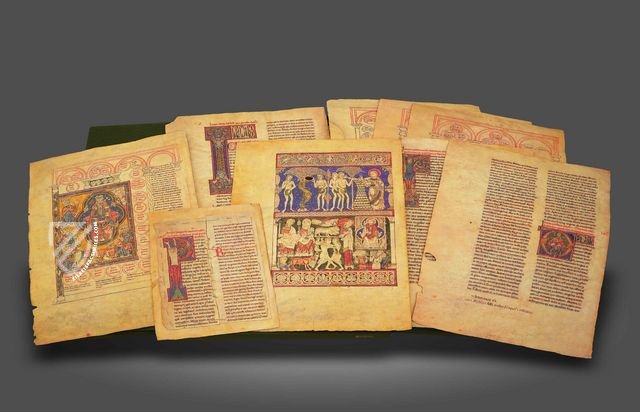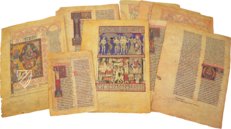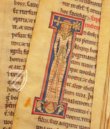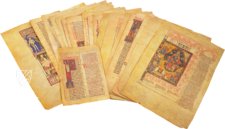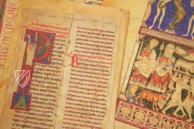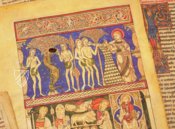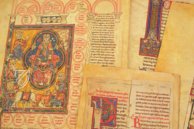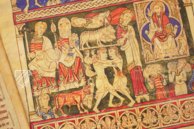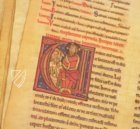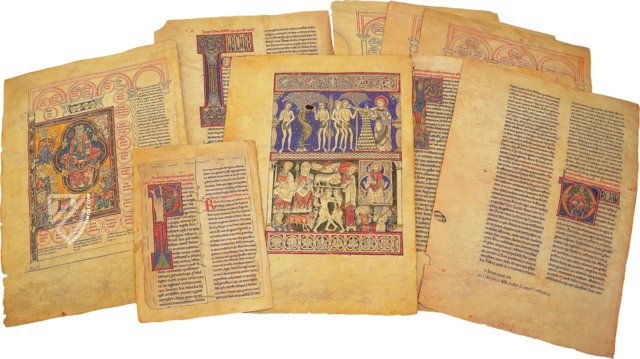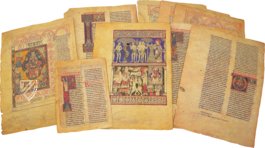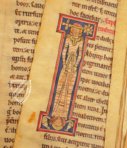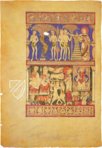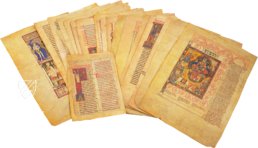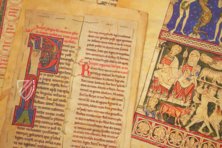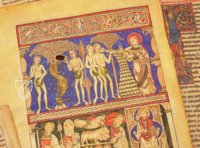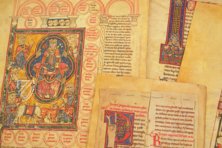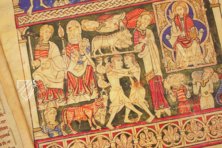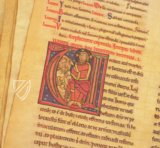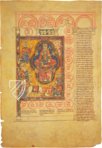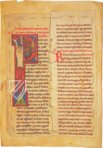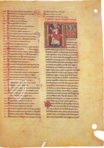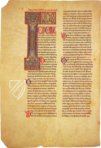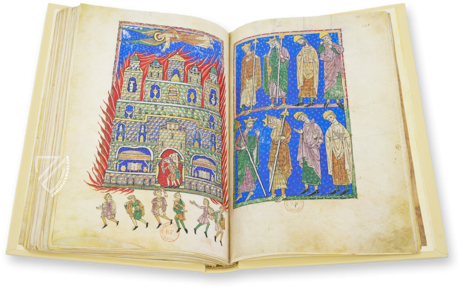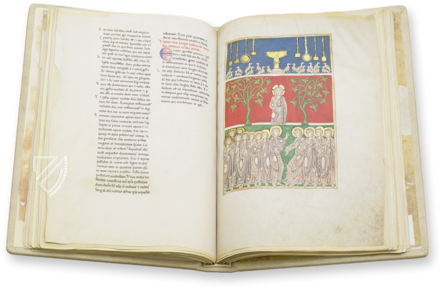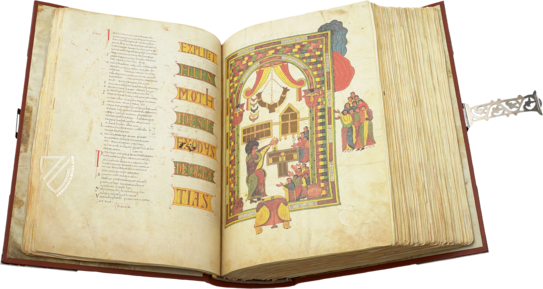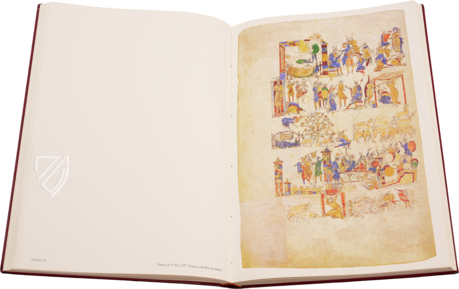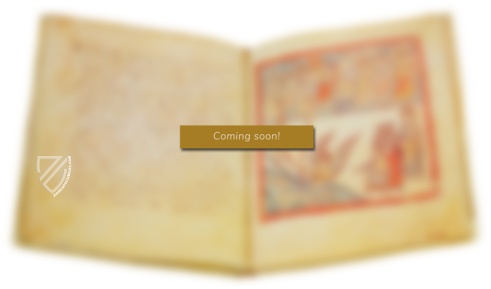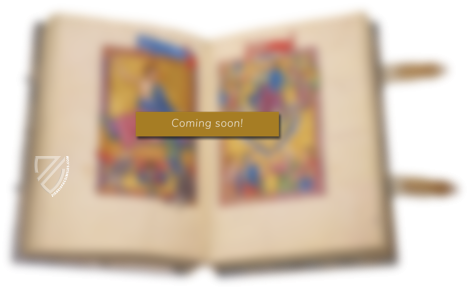Romanesque Bible of Burgos
(1,000€ - 3,000€)
A groundbreaking miniature made the so-called Bible of Burgos a main work of 12th century European illumination. Next to the innovative depiction of the Fall of Man and the Expulsion from Paradise, countless additional miniatures and initials in the codex from 1175 attest to the progressiveness of the Castilian artists in the scriptorium of San Pedro de Cardeña. The only surviving volume of the original three books enchants not only with its significant miniatures—sometimes typically Romanesque, sometimes already pointing to Gothic illumination. The gorgeous Carolingian script in black and red lends the Bible of Burgos an additional characteristic that makes it one of the most outstanding works of the Late Romanesque.
Romanesque Bible of Burgos
A groundbreaking miniature made the so-called Bible of Burgos a main work of 12th century European illumination. Next to the innovative depiction of the Fall of Man and the Expulsion from Paradise, countless additional miniatures and initials in the codex from 1175 attest to the progressiveness of the Castilian artists in the scriptorium of San Pedro de Cardeña. The only surviving volume of the original three books enchants not only with its significant miniatures—sometimes typically Romanesque, sometimes already pointing to Gothic illumination. The gorgeous Carolingian script in black and red lends the Bible of Burgos an additional characteristic that makes it one of the most outstanding works of the Late Romanesque.
Castile – European Center of Illumination
Spanish illumination reached new heights in the 12th century. Whether on account of the grandiose Beatus codices or other manuscripts with religious content, the scriptoria of Castile were trailblazers in the innovative artistic furnishing of precious books. The scriptorium of the monastery of San Pedro de Cardeña was counted thereby among the most important sites of this artistic production. With the famous Cardeña Beatus (ca. 1180), the miniaturists of this scriptorium entered into art history. One of the artists was also likely involved in the Romanesque Bible of Burgos, which probably originated ca. 1175 in San Pedro de Cardeña. Another possible point of origin for the codex could be the royal Abbey of Santa María la Real de Las Huelgas near Burgos. Today, one of the original three volumes of the book survives. This is supplemented by two surviving fragments of the third part, which were bound in another codex from the holdings of the abbey.
The Splendor of the Late Romanesque
The codex, in an impressive format of 53 x 37 cm, assembles some of the highpoints of miniature painting of the Spanish Middle Ages or a late phase of the Romanesque on a total of 404 pages. The artists of Burgos united numerous stylistic characteristics in their pictures, which are sometimes typical for the time and innovatively point to the oncoming Gothic at others. Typical for the Romanesque style are the often overlong or very short figures and the flowing folds of the garments. On the other hand, the oft-discernable parallel folds are a Spanish characteristic. The miniatures, in their splendid colors and forms, offer a true firework for the eyes of the beholder and allowed the late phase of the great illumination of the Romanesque period to reach a final highpoint.
Unique Miniatures
The miniature of the Fall of Man and the Expulsion from Paradise are exceptional for art history. The scene on a luminous gold background is only partially colored, producing an unbelievable strong effect in the miniature. The Chiaroscuro painting already points to Gothic art. Everything has been worked-through ornamentally: the snake that entwines itself around the tree, the crowns of the trees, and the columns, which frame the miniature to the right and left. This representation is considered to be one of the most interesting and significant miniatures of European art during this epoch! Furthermore, the image pages, which are depicted in two registers from the Book of Genesis, are adorned with ornamental friezes. These show a discernable influence from insular illumination due to their artfully braided ornaments riddled with nude people and animals. Additionally, numerous initials with figurative and ornamental content append the lavish pictorial adornment of the codex. This variety of influences and new stylistic discoveries constitute the particular allure of the Romanesque Bible of Burgos, which has gone down in art history as a unique work of this great time in Spanish illumination.
Codicology
- Alternative Titles
- Biblia Románica de Burgos
Romanische Bibel von Burgos - Size / Format
- 404 pages / 53.0 × 37.0 cm
- Origin
- Spain
- Date
- Ca. 1175
- Epochs
- Style
- Genre
- Language
- Script
- Gothic Textura
Romanesque Bible of Burgos
Expulsion from Paradise
This Spanish miniature depicting Adam and Eve accepting the forbidden fruit from the serpent before being confronted by God is regarded as one of the most interesting examples of 12th century illumination. English influences, the figures and interlace frames in particular, are combined with Spanish elements like garments with parallel folds. It is the most exceptional specimen of Castilian Romanesque art and a true unicum among contemporary miniatures that seems to announce the coming of Gothic art.
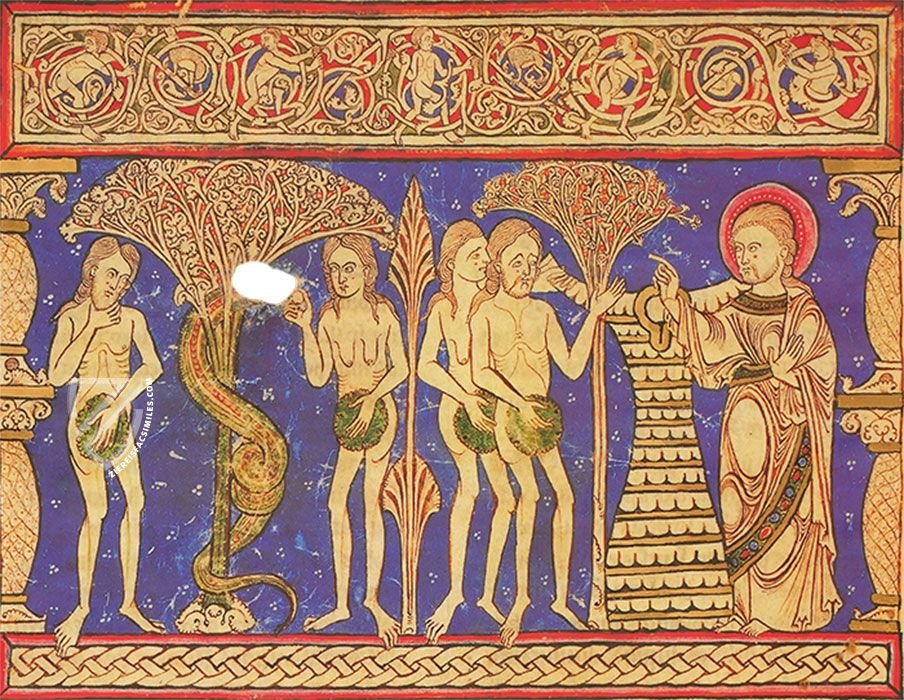
Romanesque Bible of Burgos
Adoration of the Magi and Genealogy of Christ
Set within an architectural frame with five columns and four Moorish-style horseshoe arches, this page presents a fascinating miniature of the Adoration of the Magi surrounded by medallions written in red ink representing the genealogy of Christ as well as a neatly written column of text.
The remarkable miniature is uniquely designed with the Three Magi kneeling and presenting their gifts on the left, two of them with their feet protruding into the frame. Joseph is separated from the rest of the Holy Family and is depicted on the earthly plane with the Magi and the animals while the Virgin Mary and baby Jesus are enthroned in a quatrefoil. A chorus of angels in the upper-right corner watches as homage is paid to the King of Kings.
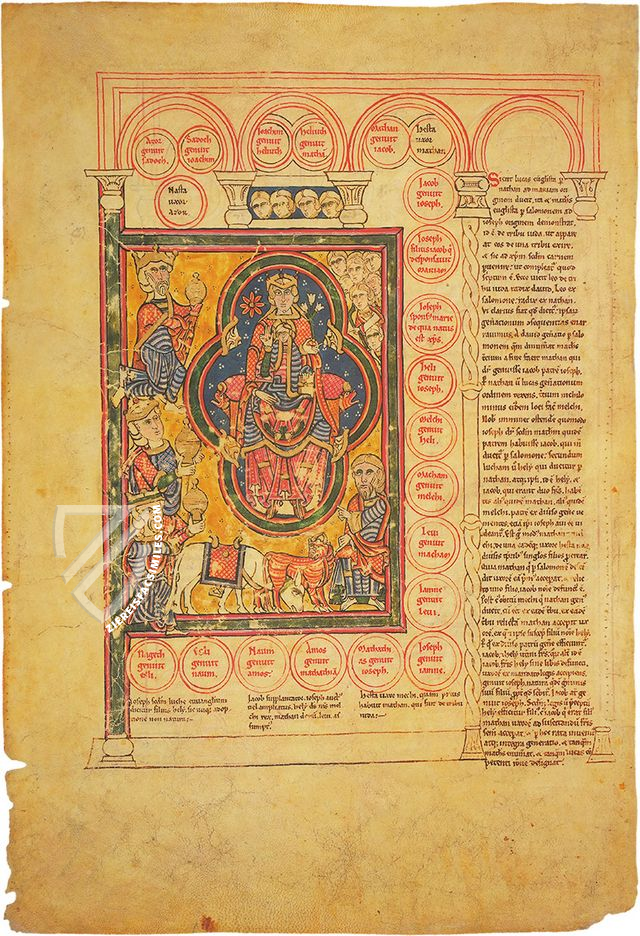
#1 Biblia Románica de Burgos
Language: Spanish
(1,000€ - 3,000€)
- Treatises / Secular Books
- Apocalypses / Beatus
- Astronomy / Astrology
- Bestiaries
- Bibles / Gospels
- Chronicles / History / Law
- Geography / Maps
- Saints' Lives
- Islam / Oriental
- Judaism / Hebrew
- Single Leaf Collections
- Leonardo da Vinci
- Literature / Poetry
- Liturgical Manuscripts
- Medicine / Botany / Alchemy
- Music
- Mythology / Prophecies
- Psalters
- Other Religious Books
- Games / Hunting
- Private Devotion Books
- Other Genres
- Afghanistan
- Armenia
- Austria
- Belgium
- Belize
- Bosnia and Herzegovina
- China
- Colombia
- Costa Rica
- Croatia
- Cyprus
- Czech Republic
- Denmark
- Egypt
- El Salvador
- Ethiopia
- France
- Germany
- Greece
- Guatemala
- Honduras
- Hungary
- India
- Iran
- Iraq
- Israel
- Italy
- Japan
- Jordan
- Kazakhstan
- Kyrgyzstan
- Lebanon
- Liechtenstein
- Luxembourg
- Mexico
- Morocco
- Netherlands
- Palestine
- Panama
- Peru
- Poland
- Portugal
- Romania
- Russia
- Serbia
- Spain
- Sri Lanka
- Sweden
- Switzerland
- Syria
- Tajikistan
- Turkey
- Turkmenistan
- Ukraine
- United Kingdom
- United States
- Uzbekistan
- Vatican City
- A. Oosthoek, van Holkema & Warendorf
- Aboca Museum
- Ajuntament de Valencia
- Akademie Verlag
- Akademische Druck- u. Verlagsanstalt (ADEVA)
- Aldo Ausilio Editore - Bottega d’Erasmo
- Alecto Historical Editions
- Alkuin Verlag
- Almqvist & Wiksell
- Amilcare Pizzi
- Andreas & Andreas Verlagsbuchhandlung
- Archa 90
- Archiv Verlag
- Archivi Edizioni
- Arnold Verlag
- ARS
- Ars Magna
- ArtCodex
- AyN Ediciones
- Azimuth Editions
- Badenia Verlag
- Bärenreiter-Verlag
- Belser Verlag
- Belser Verlag / WK Wertkontor
- Benziger Verlag
- Bernardinum Wydawnictwo
- BiblioGemma
- Biblioteca Apostolica Vaticana (Vaticanstadt, Vaticanstadt)
- Bibliotheca Palatina Faksimile Verlag
- Bibliotheca Rara
- Boydell & Brewer
- Bramante Edizioni
- Bredius Genootschap
- Brepols Publishers
- British Library
- C. Weckesser
- Caixa Catalunya
- Canesi
- CAPSA, Ars Scriptoria
- Caratzas Brothers, Publishers
- Carus Verlag
- Casamassima Libri
- Centrum Cartographie Verlag GmbH
- Chavane Verlag
- Christian Brandstätter Verlag
- Circulo Cientifico
- Club Bibliófilo Versol
- Club du Livre
- CM Editores
- Collegium Graphicum
- Collezione Apocrifa Da Vinci
- Comissão Nacional para as Comemorações dos Descobrimentos Portugueses
- Coron Verlag
- Corvina
- CTHS
- D. S. Brewer
- Damon
- De Agostini/UTET
- De Nederlandsche Boekhandel
- De Schutter
- Deuschle & Stemmle
- Deutscher Verlag für Kunstwissenschaft
- DIAMM
- Droz
- E. Schreiber Graphische Kunstanstalten
- Ediciones Boreal
- Ediciones Grial
- Ediclube
- Edições Inapa
- Edilan
- Editalia
- Edition Deuschle
- Edition Georg Popp
- Edition Leipzig
- Edition Libri Illustri
- Editiones Reales Sitios S. L.
- Éditions de l'Oiseau Lyre
- Editions Medicina Rara
- Editorial Casariego
- Editorial Mintzoa
- Editrice Antenore
- Editrice Velar
- Edizioni Edison
- Egeria, S.L.
- Eikon Editores
- Electa
- Emery Walker Limited
- Enciclopèdia Catalana
- Eos-Verlag
- Ephesus Publishing
- Ernst Battenberg
- Eugrammia Press
- Extraordinary Editions
- Fackelverlag
- Facsimila Art & Edition
- Facsimile Editions Ltd.
- Facsimilia Art & Edition Ebert KG
- Faksimile Verlag
- Feuermann Verlag
- Folger Shakespeare Library
- Franco Cosimo Panini Editore
- Friedrich Wittig Verlag
- Fundación Hullera Vasco-Leonesa
- G. Braziller
- Gabriele Mazzotta Editore
- Gebr. Mann Verlag
- Gesellschaft für graphische Industrie
- Getty Research Institute
- Giovanni Domenico de Rossi
- Giunti Editore
- Graffiti
- Grafica European Center of Fine Arts
- Guido Pressler
- Guillermo Blazquez
- Gustav Kiepenheuer
- H. N. Abrams
- Harrassowitz
- Harvard University Press
- Helikon
- Hendrickson Publishers
- Henning Oppermann
- Herder Verlag
- Hes & De Graaf Publishers
- Hoepli
- Holbein-Verlag
- Houghton Library
- Hugo Schmidt Verlag
- Idion Verlag
- Il Bulino, edizioni d'arte
- ILte
- Imago
- Insel Verlag
- Insel-Verlag Anton Kippenberger
- Instituto de Estudios Altoaragoneses
- Instituto Nacional de Antropología e Historia
- Introligatornia Budnik Jerzy
- Istituto dell'Enciclopedia Italiana - Treccani
- Istituto Ellenico di Studi Bizantini e Postbizantini
- Istituto Geografico De Agostini
- Istituto Poligrafico e Zecca dello Stato
- Italarte Art Establishments
- Jan Thorbecke Verlag
- Johnson Reprint Corporation
- Josef Stocker
- Josef Stocker-Schmid
- Jugoslavija
- Karl W. Hiersemann
- Kasper Straube
- Kaydeda Ediciones
- Kindler Verlag / Coron Verlag
- Kodansha International Ltd.
- Konrad Kölbl Verlag
- Kurt Wolff Verlag
- La Liberia dello Stato
- La Linea Editrice
- La Meta Editore
- Lambert Schneider
- Landeskreditbank Baden-Württemberg
- Leo S. Olschki
- Les Incunables
- Liber Artis
- Library of Congress
- Libreria Musicale Italiana
- Lichtdruck
- Lito Immagine Editore
- Lumen Artis
- Lund Humphries
- M. Moleiro Editor
- Maison des Sciences de l'homme et de la société de Poitiers
- Manuscriptum
- Martinus Nijhoff
- Maruzen-Yushodo Co. Ltd.
- MASA
- Massada Publishers
- McGraw-Hill
- Metropolitan Museum of Art
- Militos
- Millennium Liber
- Müller & Schindler
- Nahar - Stavit
- Nahar and Steimatzky
- National Library of Wales
- Neri Pozza
- Nova Charta
- Oceanum Verlag
- Odeon
- Orbis Mediaevalis
- Orbis Pictus
- Österreichische Staatsdruckerei
- Oxford University Press
- Pageant Books
- Parzellers Buchverlag
- Patrimonio Ediciones
- Pattloch Verlag
- PIAF
- Pieper Verlag
- Plon-Nourrit et cie
- Poligrafiche Bolis
- Presses Universitaires de Strasbourg
- Prestel Verlag
- Princeton University Press
- Prisma Verlag
- Priuli & Verlucca, editori
- Pro Sport Verlag
- Propyläen Verlag
- Pytheas Books
- Quaternio Verlag Luzern
- Reales Sitios
- Recht-Verlag
- Reichert Verlag
- Reichsdruckerei
- Reprint Verlag
- Riehn & Reusch
- Roberto Vattori Editore
- Rosenkilde and Bagger
- Roxburghe Club
- Salerno Editrice
- Saltellus Press
- Sandoz
- Sarajevo Svjetlost
- Schöck ArtPrint Kft.
- Schulsinger Brothers
- Scolar Press
- Scrinium
- Scripta Maneant
- Scriptorium
- Shazar
- Siloé, arte y bibliofilia
- SISMEL - Edizioni del Galluzzo
- Sociedad Mexicana de Antropología
- Société des Bibliophiles & Iconophiles de Belgique
- Soncin Publishing
- Sorli Ediciones
- Stainer and Bell
- Studer
- Styria Verlag
- Sumptibus Pragopress
- Szegedi Tudomànyegyetem
- Taberna Libraria
- Tarshish Books
- Taschen
- Tempus Libri
- Testimonio Compañía Editorial
- Thames and Hudson
- The Clear Vue Publishing Partnership Limited
- The Facsimile Codex
- The Folio Society
- The Marquess of Normanby
- The Richard III and Yorkist History Trust
- Tip.Le.Co
- TouchArt
- TREC Publishing House
- TRI Publishing Co.
- Trident Editore
- Tuliba Collection
- Typis Regiae Officinae Polygraphicae
- Union Verlag Berlin
- Universidad de Granada
- University of California Press
- University of Chicago Press
- Urs Graf
- Vallecchi
- Van Wijnen
- VCH, Acta Humaniora
- VDI Verlag
- VEB Deutscher Verlag für Musik
- Verlag Anton Pustet / Andreas Verlag
- Verlag Bibliophile Drucke Josef Stocker
- Verlag der Münchner Drucke
- Verlag für Regionalgeschichte
- Verlag Styria
- Vicent Garcia Editores
- W. Turnowski Ltd.
- W. Turnowsky
- Waanders Printers
- Wiener Mechitharisten-Congregation (Wien, Österreich)
- Wissenschaftliche Buchgesellschaft
- Wissenschaftliche Verlagsgesellschaft
- Wydawnictwo Dolnoslaskie
- Xuntanza Editorial
- Zakład Narodowy
- Zollikofer AG

